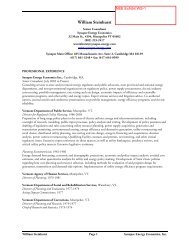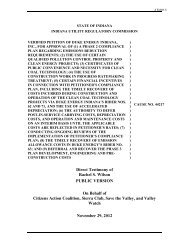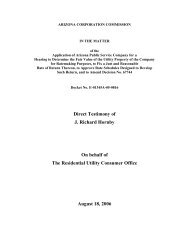Best Practices in Energy Efficiency Program Screening - Synapse ...
Best Practices in Energy Efficiency Program Screening - Synapse ...
Best Practices in Energy Efficiency Program Screening - Synapse ...
Create successful ePaper yourself
Turn your PDF publications into a flip-book with our unique Google optimized e-Paper software.
Illustrative Example<br />
Figure 4.1, provides the benefit-cost ratios under the PAC test, the TRC test with OPIs<br />
<strong>in</strong>cluded, and the TRC test without OPIs <strong>in</strong>cluded for our example utility. The OPIs that<br />
we use here are the ones that are currently <strong>in</strong> use by Massachusetts energy efficiency<br />
program adm<strong>in</strong>istrators (NMR 2010).<br />
First, it is <strong>in</strong>terest<strong>in</strong>g to note the difference between the results under the PAC test<br />
relative to the TRC test without OPIs. The low-<strong>in</strong>come programs are identical under<br />
these two tests because the customers are not required to make any contribution toward<br />
the <strong>in</strong>cremental cost of efficiency measures. The C&I programs are more cost-effective<br />
under the PAC test than the TRC test, because customers contribute towards the<br />
<strong>in</strong>cremental efficiency measure cost, and the OPIs for C&I programs are assumed to be<br />
relatively small.<br />
Second, it is <strong>in</strong>terest<strong>in</strong>g to note the difference between the results under the TRC test<br />
with and without OPIs. The low-<strong>in</strong>come programs are much more cost-effective with the<br />
OPIs <strong>in</strong>cluded because of the low-<strong>in</strong>come other program benefits and the other fuel<br />
sav<strong>in</strong>gs. The residential new construction and retrofit programs are much more costeffective<br />
with the OPIs <strong>in</strong>cluded because of the other fuel sav<strong>in</strong>gs. These two OPIs (low<strong>in</strong>come<br />
other program benefits and other fuel sav<strong>in</strong>gs) account for the vast majority of<br />
the differences between the cases with and without OPIs.<br />
Figure 4.1. Cost-Effectiveness Analysis for OPIs<br />
Source: The 2012 energy efficiency plan for our example utility, with modified assumptions as noted.<br />
With regard to C&I programs, there are very few OPIs applied to the C&I sector. This<br />
may be primarily due to the fact that this sector has not been studied as much as the<br />
| 40 <strong>Best</strong> <strong>Practices</strong> <strong>in</strong> <strong>Energy</strong> <strong>Efficiency</strong> <strong>Program</strong> Screen<strong>in</strong>g | www.nhpci.org







